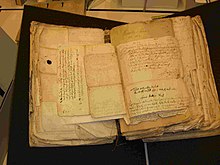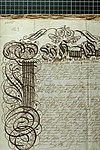Zurlauben Collection
The Zurlauben Collection , also known as the Zurlaubiana , consists of the written estate of the Zurlauben family of magistrates in Zug . The collection has been in the Aargau Cantonal Library in Aarau , Switzerland , since 1803 . In the editing and cataloging project of the same name, started in 1973, the Acta Helvetica created by Beat Fidel Zurlauben are processed and provided with registers of places and persons. The financial sponsors of the major project based at the Aargau canton library are the Swiss National Science Foundation, the cantons of Aargau, Zug, Solothurn, Lucerne (until 2008), Schwyz, Uri, Nidwalden and Obwalden, and the city of Zug.
history
The name of the Zurlaubiana goes back to a famous family of magistrates from Zug who had a major influence on political and social life in the canton of Zug and Catholic Switzerland in the 16th, 17th and 18th centuries . It is thanks to the collecting activities of their last male descendant, Lieutenant General Beat Fidel Zurlauben (1720–1799) that the collection was handed down in its present size. In addition to his military career as an officer in the service of the French crown, Beat Fidel Zurlauben devoted himself extensively to intellectual activities as a historian and writer.
When the pension payments were cut in connection with the French Revolution , Beat Fidel Zurlauben sold his library to the Benedictine Abbey of St. Blasien in the Black Forest in 1795 . The collection remained in Zug for the time being.
After Beat Fidel Zurlauben's death in 1799, the newly established Helvetic government became aware of the extensive library. Recognizing the great value of the collection, the then education minister, Philipp Albert Stapfer (1766–1840) from Aargau, confiscated the Zurlauben library. He justified this measure with the argument that these important documents of patriotic history should not go abroad. The St. Blasien monastery had to be satisfied with financial compensation. Later on, Stapfer made a significant contribution to the fact that the library and the manuscript collections could be acquired by the newly created canton of Aargau in 1803 , where they are kept in the warehouse of the Aargau canton library to this day .
Duration
The inventory includes around 10,000 printed works, including around 30 incunabula and a large number of valuable first editions. Many of these rarities were acquired by Beat Fidel Zurlauben (1720–1799) at auctions of large princely libraries, abolished monasteries and religious settlements or come from the libraries of scholars such as Gottlieb Emanuel von Haller . In addition, the library contains around 200 independent manuscripts such as chronicles, plays, medicine books, horse training books and account books, school and college notebooks etc. of inestimable historical value.
The document collection comprises about 350 manuscript anthologies with a total of about 50,000 handwritten individual documents and is a mix of family archives, political and scientific estate. On the one hand come the documents namely the archives of the family Zurlauben that away important for several generations offices in the areas of military, Church and state held and on the other hand the journalistic and scientific activities of Beat Fidel Zurlauben, who dealt extensively with Swiss history, the history of the Swiss nobility and mercenaries.
What is particularly interesting about the Zurlaubiana is that it not only contains obviously important documents, but also a large number of initially unimportant notes, invoices and letters that only reveal their value to the reader on closer inspection. In addition to important documents and contracts, private correspondence with French ambassadors, court judgments and poems, the surviving documents also include simple New Year's wishes, lists of sponsored gifts, household bills and the like.
In their entirety, the documents give us an insight into everyday life in the old Swiss Confederation of the 17th and 18th centuries and at the same time open up the perspective for more specific analyzes in areas such as mercenaries, clientele and power structures, social history, the history of mentality, everyday history and much more.
Zurlaubiana edition project
The Acta Helvetica, Gallica, Germanica, Hispanica, Sabaudica necnon Stemmatis Zur-Laubiani , or Acta Helvetica (AH) for short, form part of the extensive collection of files . Beat Fidel Zurlauben compiled this 186-volume section with over 35,000 individual documents without a chronological or thematic structure, which made it difficult for scholars to access the valuable sources for a long time. Since 1973 these documents have been edited in a long-term edition project and made available to the public. With the help of detailed registers of persons, places and letters, access to the Acta Helvetica inventory is facilitated and made fruitful for research. As part of this project, 172 of the 186 Acta Helvetica volumes have been published so far (as of November 2012).
literature
- André Holenstein: Political History of the Early Modern Eidgenossenschaft and the Helvetic Republic , in: Traverse 2013, No. 1, pp. 49–87 (on the electronic indexing of the Zurlauben Collection see p. 52).
- Carmen Furger: The development of Acta Helvetica from the estate of the Zurlauben family in Zug , in: Tugium 28, 2012, pp. 7-14, (ill.).
- Hächler, Stefan: Round Table: Requirements for a Modern Source Edition. The example of the Zurlaubiana, in: Bulletin Pro Saeculo XVIII °, No. 31, 2007, pp. 20-22.
- Werner Dönni: 200 years of the Aargau Cantonal Library - zur Zurlaubiana , in: Arbido , vol. 18, no. 9, September 2003, pp. 8–9. (Ill.)
- Werner Dönni: The Zurlaubiana. A scholarly library of the 18th century , in: Heimat am Hoch-Rhein, Jahrbuch des Landkreis Waldshut, Volume 25 (2000), pp. 91–99.
- Rainer Stöckli: Acta Helvetica, a treasure trove for Zug's history , in: Ders .: Späne from the workbench of a history friend, Unterentfelden (self-published), pp. 16–21.
- Kurt-Werner Meier: The Zurlaubiana. Become - Owner - Analyzes. A Zug family collection. Basic stock of the Aargau Cantonal Library , 2 volumes, Aarau 1981. Digital copies from the Aargau Cantonal Library: Volume 1 (PDF, 138 MB), Volume 2 (PDF, 108 MB).
- Kurt-Werner Meier, Josef Schenker, Rainer Stöckli; Urs Amacher (arrangement): Collection Zurlauben. Regests and registers for Acta Helvetica , Aarau 1976ff.
- Kurt-Werner Meier, Josef Schenker, Rainer Stöckli: The Zurlaubiana and its development , in: Zuger Neujahrsblatt, Zug 1975, pp. 83–91.
- Alfred Häberle: Collectanea Turri-Laubiana. The manuscript anthologies of the Zurlauben library in the Aargau Cantonal Library in Aarau and their indexing, in: Festschrift Karl Schib, 1968, pp. 327-360.
- Nold Halder: The Zurlaubiana - an overview according to library, historiographical points of view , in: Festgabe Otto Mittler, Aarau, print HR Sauerlaender, 1960. pp. 261–323.
- Hans Herzog: Take it easy . In: Allgemeine Deutsche Biographie (ADB). Volume 45, Duncker & Humblot, Leipzig 1900, p. 506 f.
Web links
- Zurlauben collection on the Aargau Cantonal Library website
- Acta Helvetica near Aargau digital (full-text searchable PDF files of all published volumes)
- Aargau Cantonal Library
- Conference report Requirements for a modern source edition. The example of the Zurlaubiana. June 30, 2007, Aarau , in: H-Soz-u-Kult, July 27, 2007


